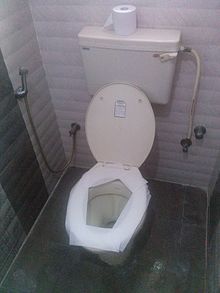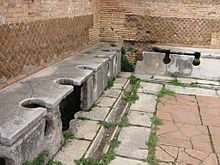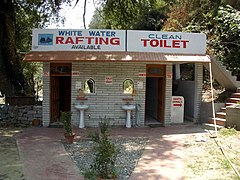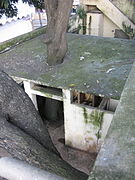Public toilet

A public toilet (also called a bathroom, restroom, latrine, comfort room, powder room, toilet room, washroom, water closet, W.C., public lavatory, lav, convenience, loo[1]) is a room or small building containing one or more toilets and possibly also urinals which is available for use by the general public, or in a broader meaning of "public", by customers of other services. Public toilets are commonly separated by sex into male and female facilities, although some can be unisex, particularly the smaller or single occupancy types. Increasingly, public toilets incorporate accessible toilets and features to cater for people with disabilities.
Public toilets may be unattended or be staffed by a janitor (possibly with a separate room), or attendant, provided by the local authority or the owner of the larger building. In many cultures, it is customary to tip the attendant, while other public toilets may charge a small fee for entrance, sometimes through use of a coin operated turnstile. Some venues such as nightclubs may feature a grooming service provided by an attendant in the room. Portable toilets are often provided at festivals and at temporary events for public use.
Public toilets are typically found in railway stations, schools, bars, restaurants, nightclubs or filling stations as well as on longer distance public transport vehicles. In many Asian, African and Muslim countries in the Middle East and North Africa region, public toilets are of the squat toilet type for cultural reasons and also because many people regard them as more hygienic than sitting toilets when used by many different people, as is the case in public settings.
Terminology


In American English, the term "restroom" usually denotes a public, commercial, or industrial personal hygiene facility designed for high throughput, whereas the term "bathroom" is used to denote a facility that is smaller and often in a residence, with lesser throughput (i.e., often for only one person at a time to use). The word "restroom" originated in the United States, but "bathroom" is now more commonly used. Some Americans prefer "restroom" over "bathroom" because public restrooms rarely have bathtubs. The word "washroom" is often used in the United States for a "laundry room" or utility room.
In Canada, "bathroom" is generally used to refer to the room in the home, though "washroom" is sometimes used, with items in the room still being described with the adjective "bathroom". Public facilities, on the other hand, are always called "washrooms". As men's and ladies' facilities are not normally situated next to each other in Canadian department stores, they may be referred to simply as "the ladies' room" or "the men's room". The word "toilet" generally denotes the fixture itself rather than the room. The word "washroom" is never used to mean "utility room" or "mud room" in Canada.
In Britain, Australia, Hong Kong (as "toilets"), Singapore (as "toilet") and New Zealand, the terms in use are "public toilet", "public lavatory" and more informally, "public loo". A "bathroom" is a room containing a bath, a "washroom" is a room for washing hands, and a "restroom" is a room to rest in when tired; none of which would necessarily contain a toilet. Public toilets were traditionally signed as "Gentlemen" or "Ladies", and as the Gents or the Ladies; these terms remain in colloquial use.
In the Philippines, "comfort room", or "C.R." for short, is the most common term in use.[2]
In non-English speaking Europe, either the local translation of "toilet" (for example "toilettes" in French), or "WC" (abbreviation for "water closet") are common.
Design


A portable toilet is a temporary outdoor public toilet enclosure which can either be connected to the local sewage system, or instead store the waste for removal from time to time. Portable toilets may be cleaned on location, or at a central location in the case of a mobile toilet or urinal which is removed for emptying.
Some public toilet facilities are mobile, and can thus be put in place where and when needed, such as for a weekend at an entertainment venue. Other temporary designs can be sunk into the ground (and thereby made inoperable), for the periods that they are not needed.[3] The idea behind this is that some people do not like the sight of a public toilet in the street, and they are more easily hidden rather than repeatedly moved. This type is typically installed in entertainment areas and made operational only during weekend evenings and nights.
Some public toilets are located underground. This practice was introduced in the United Kingdom in the 19th century, in built up urban areas where there was no space to provide them above ground. The facilities could be accessed by stairs, and were lit by skylights looking into the street. Underground public toilets were often built as a high standard by local health boards of the Victorian age, although there was a much higher provision for men than ladies as it was thought that men were out of the household more than women. In the City of London which had a male dominated workforce, there was originally limited provision for women. In the UK, underground toilets do still remain but in smaller numbers. Most were closed as they did not have disabled access, and were more prone to vandalism and sex abuse, especially if there was no attendant. A number remain in London and charge on average 50p, but others have been converted into alternative uses such as cafes, bars and even residential properties.
In Europe and the US, permanent public toilets are often installed and maintained by private firms which are then permitted to use the external surfaces of the enclosures for advertising. The installations are part of a street furniture contract between the out-of-home advertising company and the city government, and allow these public conveniences to be installed and maintained without requiring funds from the municipal budget.
Some public toilets have begun to be provided with flushable paper toilet seat covers which allow the user the comfort of knowing that they are not in contact with a surface previously used by a stranger. However, there is no scientific evidence that these prevent the spread of disease.[4]
The introduction of a 'Self Cleaning Toilet' known as The Sanisette was first seen in Paris and produced by the French company JCDecaux. It works by cleaning and disinfecting the toilet automatically, within 60 seconds after a person has finished using it.[5]
Gender and public toilets
Public toilets may be segregated by gender as indicated by written signs or pictograms of a man or a woman, or alternatively may be used without this distinction (see unisex public toilet). Amnesty International includes segregated toilets among its list of suggested measures to ensure the safety of girls in schools.[6] In many cultures, separation by sex or gender is so characteristic of public toilets that pictograms of a man or a woman are used to indicate locations of the respective toilets, often without explicit reference to the fixtures themselves. In restaurants and other private locations, the identifications can be designed to match the decoration of the premises.[7] In jurisdictions using the Uniform Plumbing Code, sex separation is a legal mandate via the building code.[8]
Gender-segregated public toilets are a source of difficulty for some people; for example, men caring for babies may find that only the women's toilet has been fitted with a baby changing facility. Single men (such as divorced fathers) have similar problems when exercising visiting rights to their young daughters if they have only public areas to resort to. Legislation has been proposed in California that "requires buildings owned or partially owned by state or local governments, as well as other private buildings open to the public, as specified, to maintain at least one safe, sanitary, and convenient baby diaper changing station that is accessible to women and men".[9][10][11][12] People with disabilities who need assistance to use the restroom have an additional problem if their helper is a different gender to themselves. Transgender and gender non-conforming persons also may be subject to embarrassment, harassment, or even assault or arrest by others offended by the presence of a person they interpret as being of a different gender (whether due to their outward presentation or their anatomical sex) to themselves.[13]
A significant number of facilities have either individual or gender-neutral facilities, such as unisex bathrooms, to accommodate people with disabilities, elderly persons who may require assistance from a carer of another gender, or other cases where public gender-segregated facilities might lead to discomfort.[14] There are also gender-neutral toilets in cases where gender-segregated ones are not practical, such as in airliners, trains, and buses. Toilet facilities for the disabled, especially those reliant on a wheelchair, may be either unisex or gender-specific.[15]
In Unicode
Unicode provides several symbols for restrooms.[16]
| Symbol | Code | Name | Value | Image |
|---|---|---|---|---|
| 🚹 | U+1F6B9 | MENS SYMBOL | men's restroom | |
| 🚺 | U+1F6BA | WOMENS SYMBOL | women's restroom | |
| 🚻 | U+1F6BB | RESTROOM | restrooms or unisex restroom | |
| 🚼 | U+1F6BC | BABY SYMBOL | baby changing station | |
| ♿ | U+267F | WHEELCHAIR SYMBOL | disabled accessible facilities | |
| 🚽 | U+1F6BD | TOILET | restroom | |
| 🅏 | U+1F14F | SQUARED WC | restroom with flush toilet | |
| 🚾 | U+1F6BE | WATER CLOSET | restroom with flush toilet | |
| 🚿 | U+1F6BF | SHOWER | shower facilities | |
| 🛀 | U+1F6C0 | BATH | bathing facilities | |
| 🛁 | U+1F6C1 | BATHTUB | bath facilities | |
| Source: [16][17] | ||||
Fixtures


Public toilets generally contain several of the following fixtures:
- Air fresheners or odour control systems
- Antiseptic handwash dispensers or soap dispensers - pump bottle or auto dispenser
- Bidets (not universal; most common in Western and Central Europe)
- Garbage can
- Hand dryer - manual or with auto sensors
- Handwash faucets / taps - some lowered for children and handicapped
- Infant changing tables, often fold-down (usually in women's rooms but in Western countries more accessible recently in men's rooms partly due to laws and legislations[10])
- Mirrors, usually over sinks
- Paper towels - often when hand dryers are not installed; sometimes with auto-sensors for touchless dispensing
- Sometimes showers are also present, often with soap, shampoo, or similar dispensers (often at truck stops)
- Toilets located within stalls with locking doors
- Urinals (almost exclusively in men's rooms; see female urinal)
- Vending machines dispensing condoms, diapers / nappies, painkillers, energy drinks, perfume, breath mints, tissues, confectionery, undergarments, swimwear, soap, sex toys or sanitary napkins or tampons
- Coat Hooks are present either in the restroom or within the stalls.
- "Pull-down" purse holders, usually attached to the stall's wall.
Usually a public toilet will consist of a commercial toilet, which will usually rely on a flushometer with a stronger and louder flush than a home-usage toilet. Some very high-vandalism settings, such as beaches or stadiums, will utilize metal toilets.
Modern public toilet architecture

The architect Frank Lloyd Wright claimed to have "invented the hung wall for the w.c. (easier to clean under)" when he designed the Larkin Administration Building in Buffalo, New York in 1904. The Hundertwasser toilet block, a colourful public toilet in Kawakawa, New Zealand was designed by Austrian artist Friedensreich Hundertwasser.
Modern public toilets usually have the following features:
- Doorless entry (labyrinth entrance) prevents the spread of disease that might otherwise occur when coming in contact with a door. Doorless entry provides visual privacy while simultaneously offering a measure of security by allowing the passage of sound. Doorless entry also helps deter vandalism; fewer audible clues to another person entering discourages some vandals. Doorless entry may also be achieved simply by keeping an existing door propped open, closed only when necessary.
- Sensor-operated fixtures (faucets, soap dispensers, hand dryers, paper towel dispensers) prevent the spread of disease by allowing patrons to circumvent the need to touch common surfaces. Sensor-operated fixtures also help conserve water by limiting the amount used per flush, and require less routine maintenance.
Service access and utilities passages

Modern public toilets often have a service entrance, utilities passages, and the like, that run behind all the fixtures. Wall-mount toilets that bolt on from behind the wall have replaced floor-mount toilets. Sensors are installed in a separate room, behind the fixtures. Usually the separate room is just a narrow corridor, or narrow passageway. Each sensor views through a small window into each fixture. Sometimes the metal plates that house the sensor windows are bolted on from behind, to prevent tampering. Additionally, all of the electrical equipment is safely behind the walls, so that there is no danger of electric shock. However, a RCCB must be (and usually is) still used for all such electrical equipment.
Service lighting consisting of windows that run all the way around the outside of the toilet uses electric lights behind the windows, to create the illusion of extensive natural light, even when the toilets are underground or otherwise do not have access to natural light. The windows are sometimes made of glass brick, permanently cemented in place. Lighting installed in service tunnels that run around the outside of the toilets provides optimum safety from electrical shock (keeping the lights outside the toilet), hygiene (no cracks or openings), security (no way for vandals to access the light bulbs), and aesthetics (clean architectural lines that maintain a continuity of whatever aesthetic design is present, e.g., the raw industrial urban aesthetic that works well with glass brick).
Older toilets do not often have service ducts and often in old toilets that have been modernized, the toilet cistern might be hidden in a purpose-built 'box' tiled over. Often old toilets might still have high-level cisterns in the service ducts. On the outside, the toilet will be flushed by a handle (just like an ordinary low-level cistern toilet) although behind the wall this handle will activate a chain. Sometimes a long flushing trough will be used to ensure that the cistern can be refilled quickly after dual flushes. This trend of hiding cisterns and fittings behind the walls started in the late 1930s in the United States and in the United Kingdom from the 1950s and by the late 1960s it was unusual for toilet cisterns to be visible in public toilets. In some buildings such as schools, however, a cistern can still be visible, although high-level cisterns had become old-fashioned by the 1970s and a lot of schools now have low-level cisterns.
Some toilets also function, in part, as changerooms, owing to their gender-segregated nature. For example, in beach areas, a portion of the building is equipped with benches so that persons can change into or out of their bathing suits.
History


Public toilets were commonly used in Ancient Rome, often in the proximity or as part of public baths.[18] By the Middle Ages public toilets became uncommon, with only few attested in Frankfurt in 1348, in London in 1383, and in Basel in 1455.[19]
In the early 19th century, large cities in Europe started installing public toilets: first in Paris, then in Berlin in 1820 and in London in 1851.[19]
Society and culture

Graffiti
Public toilets have been associated with graffiti, often of a transgressive, gossippy, or low-brow humorous nature (cf. toilet humour). The word latrinalia—from latrine 'toilet' and -alia, signifying a collection—was coined to describe this kind of graffiti.[20] A famous example of such artwork was featured on the album cover of the satirical Tony-award Broadway musical Urinetown, using felt tip pen scribblings.
Sociology
With the Jim Crow laws prior to the Civil Rights Act of 1964, bathrooms in the US were subject to segregation between whites and blacks.[21] In the 21st century, with increased exposure of the transgender community, there have been some initiatives calling for gender-neutral bathrooms instead of only male and female bathrooms to accommodate genderqueer individuals.[22]
Legislation
United Kingdom
In the United Kingdom, the Workplace (Health, Safety and Welfare) Regulations 1992 requires businesses to provide toilets for their employees,[23] along with washing facilities including soap or other suitable means of cleaning. Guidance on how many toilets to provide and what sort of washing facilities should be provided alongside them is given in the Workplace (Health, Safety and Welfare) Approved Code of Practice and Guidance L24, available from Health and Safety Executive Books.[24]
But there is no legal obligation on local authorities in the United Kingdom to provide public toilets, and although in 2008 the House of Commons Communities and Local Government Committee called for a duty on local authorities to develop a public toilet strategy,[25] this was rejected by the Government.[26]
As a result of the Sexual Offences Act 2003, sexual acts in a public toilet are illegal.[27][28][29]
Gallery
-
Typical North American public restroom
-
Public toilet at the Vienna State Opera has recorded music
-
19th-century gents' washroom at University of Oslo
-
Roadside squat toilet near Toulouse, France
-
Sanisette automated public toilet in Paris, France
-
Movable handicap-access toilet in Luxembourg
-
Public pay toilet in Kenya
-
Squat toilets in Beijing, China
-
Old-style public toilet in a Hong Kong factory
-
Entrance to public restrooms at Seoul World Cup Stadium
-
Public toilet aboard a train in the Czech Republic
-
Coach class public toilet for Czech train
-
Squat toilet in a high-speed train on the Guangshen Line in China
-
Squat toilet aboard a Japanese Ginga train
-
Roadside public toilet in Japan
-
Public toilet at Jozankei Hot Springs, Hokkaido, Japan
-
Entrance to an underground public toilet in Japan
-
Vending machines at a Japanese public toilet
-
Public toilets near Kullu, India
-
Public toilet near cinema in Bangalore, India
-
Public toilet in Kuskovo, near Moscow, Russia
-
Public toilet in Pukekohe, New Zealand
-
Historic landmark public toilets in Wellington, New Zealand
See also
References
- ^ "We managed to find a public loo," source; "But could I find a public loo anywhere? No," source
- ^ http://globalnation.inquirer.net/cebudailynews/news/view/20100605-273947/Health-official-1-CR-for-every-classroom
- ^ "Street toilets go telescopic". news.bbc.co.uk. Retrieved 20 January 2014.
- ^ MIT medical: Ask Lucy archive on paper toilet seat covers. June 28, 2006
- ^ Mulrooney, Thomas. "Public Toilets Around the World". Plumbworld News. Retrieved 20 January 2014.
- ^ "Six steps to stop violence against schoolgirls, Document ACT 77/008/2007". Amnesty International. November 2007. Retrieved 2009-02-27.
- ^ Michael, Jane; Michael Stern (1999-09-13). "Operators shouldn't get potty over bathroom symbols". Nation's Restaurant News. Retrieved 2009-02-27.[dead link]
- ^ 2009 UNIFORM PLUMBING CODE, 412.3 (PDF). Ontario, California: International Association of Plumbing and Mechanical Officials. 2009. p. 34. ISSN 0733-2335.
- ^ Senate Floor Analyses http://leginfo.legislature.ca.gov/faces/billAnalysisClient.xhtml?bill_id=201320140SB1358#
- ^ a b "Should men's restrooms have diaper changing tables? New bill says yes". Retrieved 6 July 2014.
- ^ Jerry Brown vetoes bills to help men change baby diapers Sacramento Bee. SEPTEMBER 19, 2014 http://www.sacbee.com/news/politics-government/capitol-alert/article2610428.html
- ^ SB-1358 Baby diaper changing stations http://leginfo.legislature.ca.gov/faces/billNavClient.xhtml?bill_id=201320140SB1358
- ^ Rosen, Jill (2011-04-24). "Victim of McDonald's beating speaks out". The Baltimore Sun. Retrieved 2012-08-18.
- ^ Devine, Shannon (2004-03-11). "Inclusive toilets". McGill Reporter. Retrieved 2009-02-27.
- ^ Toilet Signs at Adept Safety Online (informative commercial site)
- ^ a b Unicode.org, Transport and Map Symbols (accessed 6 November 2012)
- ^ Unicode.org, Miscellaneous Symbols (accessed 6 November 2012)
- ^ Heikki S. Vuorinen (2010): "Water, toilets and public health in the Roman era", in Water Science & Technology: Water Supply, pg.211
- ^ a b Peter Kasza:"Das große Latrinum: 155 Jahre öffentliche Toilette", in Der Spiegel, 22 June 2007
- ^ Palazzolo, Rose. "Latrinalia - Learning From the Scrawls in the Bathroom". ABC News. Retrieved 30 October 2013.
- ^ Practical Guide to Cost Segregation - Page 44, Cathy A. Harris - 2008
- ^ Toilet: Public Restrooms and the Politics of Sharing - Page 192, Laura Noren - 2010
- ^ Workplace (Health, Safety and Welfare) Regulations 1992
- ^ Health and Safety Executive Books
- ^ "The Provision Of Public Toilets" (PDF). House of Commons. Retrieved 20 January 2014.
- ^ "Government Response to Public Toilet Provision" (PDF). www.gov.uk. Retrieved 20 January 2014.
- ^ Galop.org.uk, Cottaging and cruising: your safety, your rights and the law.
- ^ Kingston Hospital NHS Trust, Sex and the law.
- ^ Sexual Offences Act 2003, part 1, paragraph 71,
External links
- British Toilet Association Campaigning for Better Public Toilets for All
- American Restroom Association America's advocate for the availability of clean, safe, well designed public restrooms
- Australia's National Public Toilet Map shows the location of more than 14,000 public and private public toilet facilities across Australia.
- Public Toilets Database Locations of public toilets in 18 countries. New locations and comments can be added. Detailed information includes the geographic coordinates and quality of the facility.
- Needaloo The Uk Online Disabled Loo Locator
- Safe to Pee: A Gender Neutral Restroom Directory
- Find A John: Filterable Restroom Directory



























